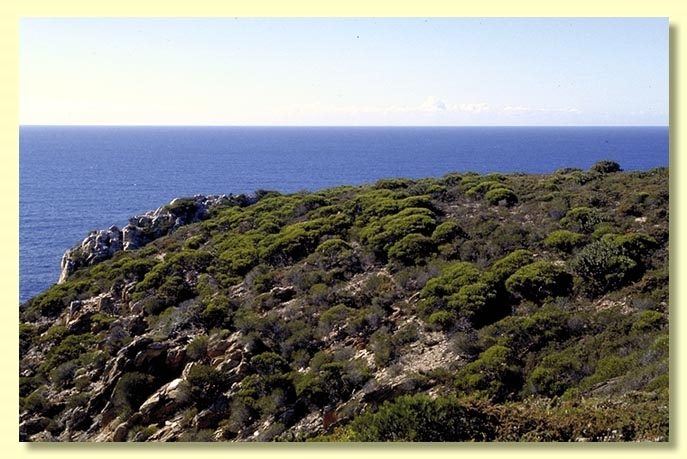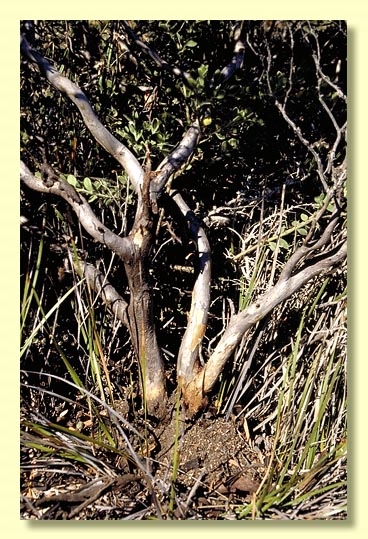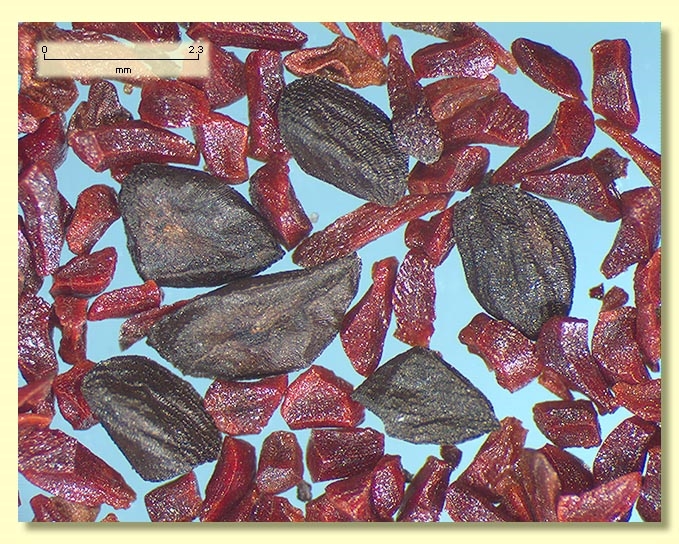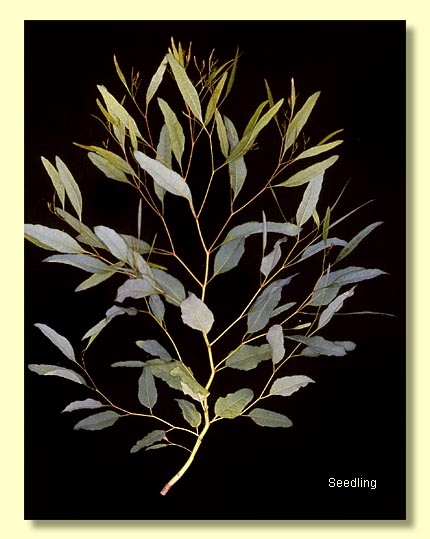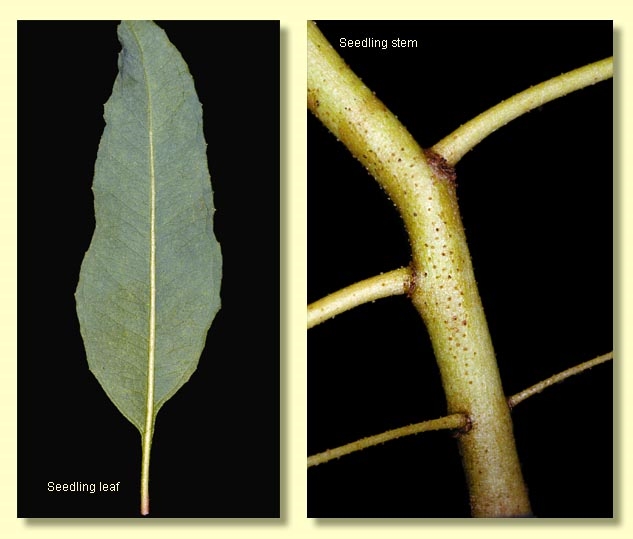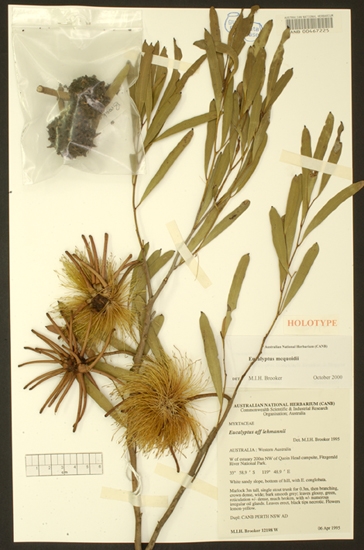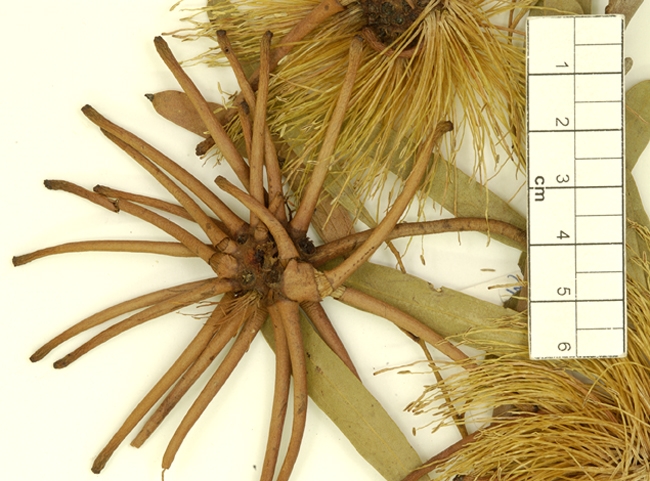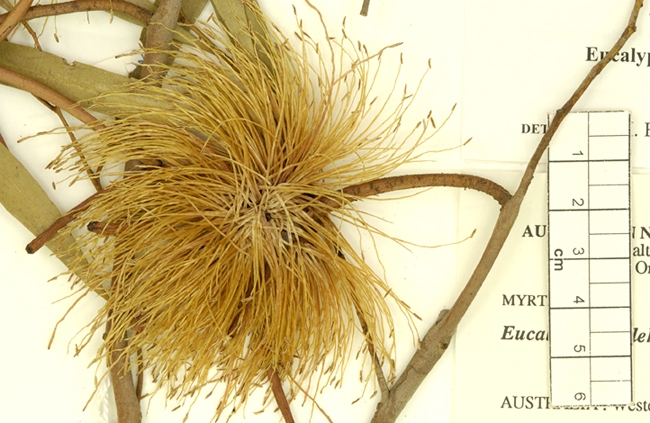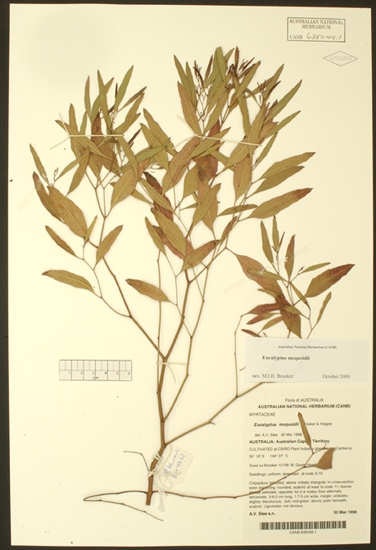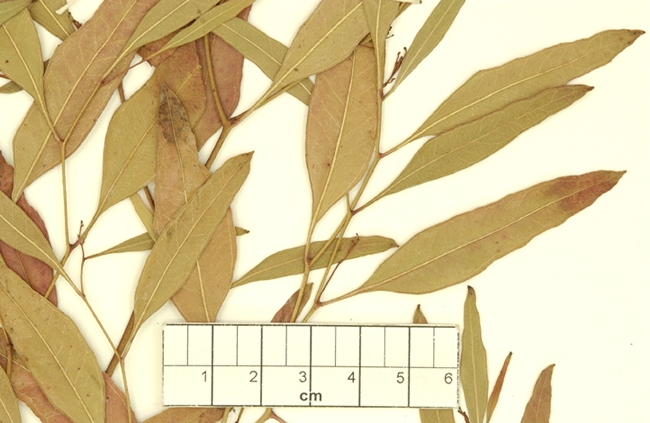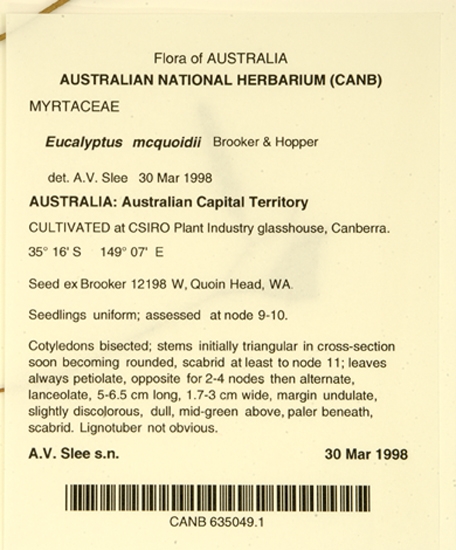Euclid - Online edition
Eucalyptus mcquoidii
Eucalyptus | Symphyomyrtus | Bisectae | Hadrotes | Lehmannianae | Conjunctae
Bark smooth throughout, pale grey and whitish.
Branchlets lacking oil glands in the pith.
Juvenile growth (coppice or field seedlings to 50 cm): true juvenile growth not seen (post-fire regrowth that is less ca 3 years old, less than 0.5 m tall and not yet reproductive has foliage the same as adult crowns).
Adult leaves held erect, alternate, petioles 0.2–0.8 cm long; blade linear to narrowly elliptic-oblong, 4.5–8 cm long, 0.5–1 cm wide, base tapering to petiole, margin entire, apex rounded and with a black warty mucro, concolorous, glossy, mid green, side-veins at an acute or wider angle to midrib (angle of lateral veins variable even within a single leaf), reticulation moderate to dense, broken, intramarginal veins remote from margin and often prominent giving the appearance of 3 main veins, oil glands obscurely island.
Inflorescence axillary unbranched, peduncles more or less terete and spreading 3–5 cm long, buds ca 21 to 50 per umbel, pedicels absent. Buds syncarpous (all of the buds in a cluster are joined by the hypanthium only, the upper part of each bud remains free, at maturity the combined length of the fused part plus operculum is ca 5–7 cm, whilst width of individual buds measured at the base of the operculum is 0.4–0.5 cm); scar present (outer operculum lost early) but may be obscure at bud maturity, operculum narrow straight to slightly curved, 4.3–6 cm long, warty at the tip, stamens erect, anthers narrowly oblong, versatile, dorsifixed, dehiscing by longitudinal slits, style long and straight, stigma blunt, small, locules 3, the placentae each with 4 vertical rows of ovules. Flowers greenish.
Fruit a syncarpous, spherical mass on spreading rounded peduncle, the individual fruit in the woody mass 0.6–1 cm wide, length not measurable, dehiscing by elliptical holes formed as the 3 valves split along the sutures but remain fused apically, disc covers surface of valves.
Seeds black, 1–2.5 mm long, ovoid to angularly so, dorsal surface shallowly reticulate, hilum ventral/terminal.
Cultivated seedlings (measured at node 10): cotyledons Y-shaped (bisected), robust; stems initially triquetrous becoming rounded in cross-section, scabrid; leaves always petiolate, opposite for 2–4 nodes then alternate, lanceolate to narrowly so, 5–8 cm long, 1.5–3 cm wide, dull, green, margin entire to irregular and undulate; stems, petioles, lamina and margin all scabrid with bristle-glands.
Flowering has been recorded in April and November.
A small shrub or stunted mallet endemic to Western Australia, so far found only in the vicinity of Quoin Head, Fitzgerald River National Park. It has smooth bark, mid-green crown, conspicuous clusters of buds fused basally, and woody fruit masses. The massed yellow-green flowers form conspicuous balls.
Eucalyptus mcquoidii belongs in Eucalyptus subgenus Symphyomyrtus section Bisectae subsection Hadrotes because the cotyledons are coarsely Y-shaped, buds have an operculum scar, a long (inner) operculum and erect stamens, fruit which are large, thick-rimmed and held rigidly on the peduncles. Of the twelve species in subsection Hadrotes ten lack oil glands in the pith of the branchlets and have scabrid seedlings. Together these ten species form series Lehmannianae, a group further characterised by having fruit with exserted valves that remain fused at their tips after seed shed, a feature shared with the more distantly related E. cornuta.
Of the ten species in series Lehmannianae six, E. conferruminata, E. lehmannii, E. mcquoidii, E. arborella, E. sinuosa and E. retusa have the buds (and fruit) in each axillary cluster fused basally (forming subseries Conjunctae), whilst the other four species, E. newbeyi, E. burdettiana, E. talyuberlup, and E. megacornuta, have buds and fruit free (forming subseries Liberae).
E. mcquoidii differs from its five close relatives by having terete peduncles plus up to ca 50 buds in each fused cluster. E. lehmannii is a mallee with inflorescences with flattened peduncle and up to 21 fused buds per cluster. E. arborella is a mallet with inflorescences similar to E. lehmannii. The remaining species in the group, E. conferruminata, is a mallet or shrub (marlock) with flattened peduncles and coarser bud clusters with opercula shorter and wider than the graceful long slender opercula found on the other five species. E. mcquoidii is most closely related to the lignotuberous shrub/mallee E. sinuosa which shares the terete peduncles but differs in having longer, sinuose opercula dilated at the tip and wider basally (to 9.5 cm long, 0.7–1.1 cm wide at base) and usually fewer buds per cluster.


